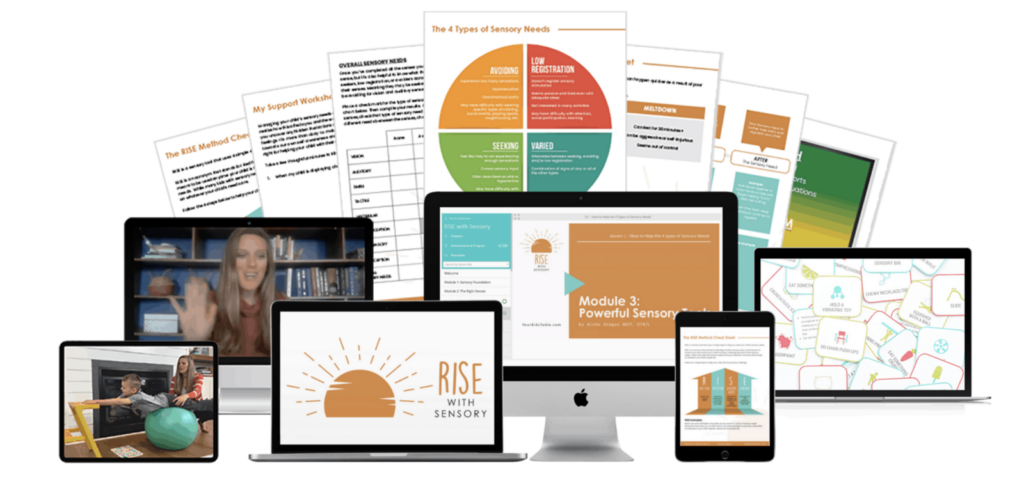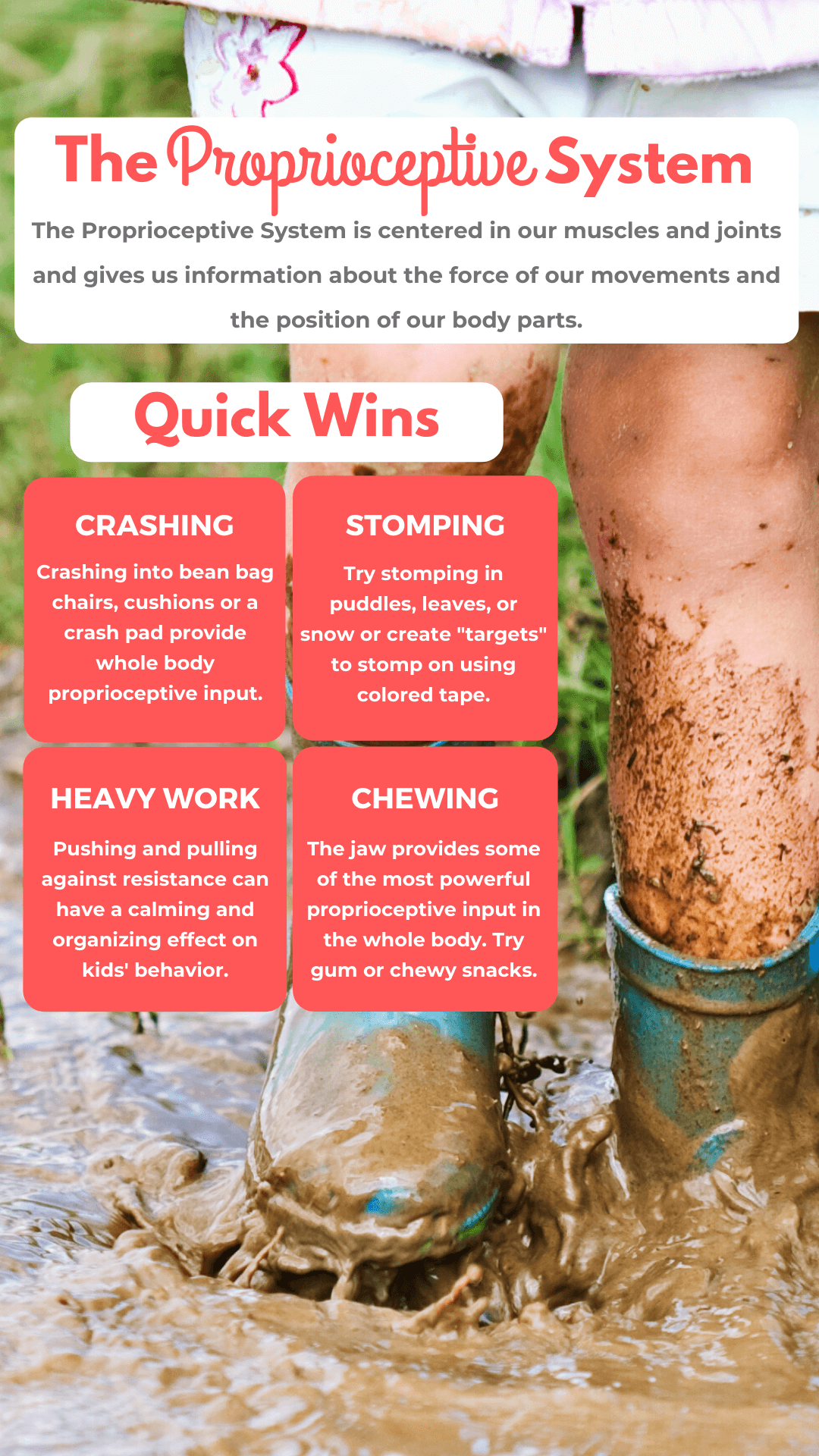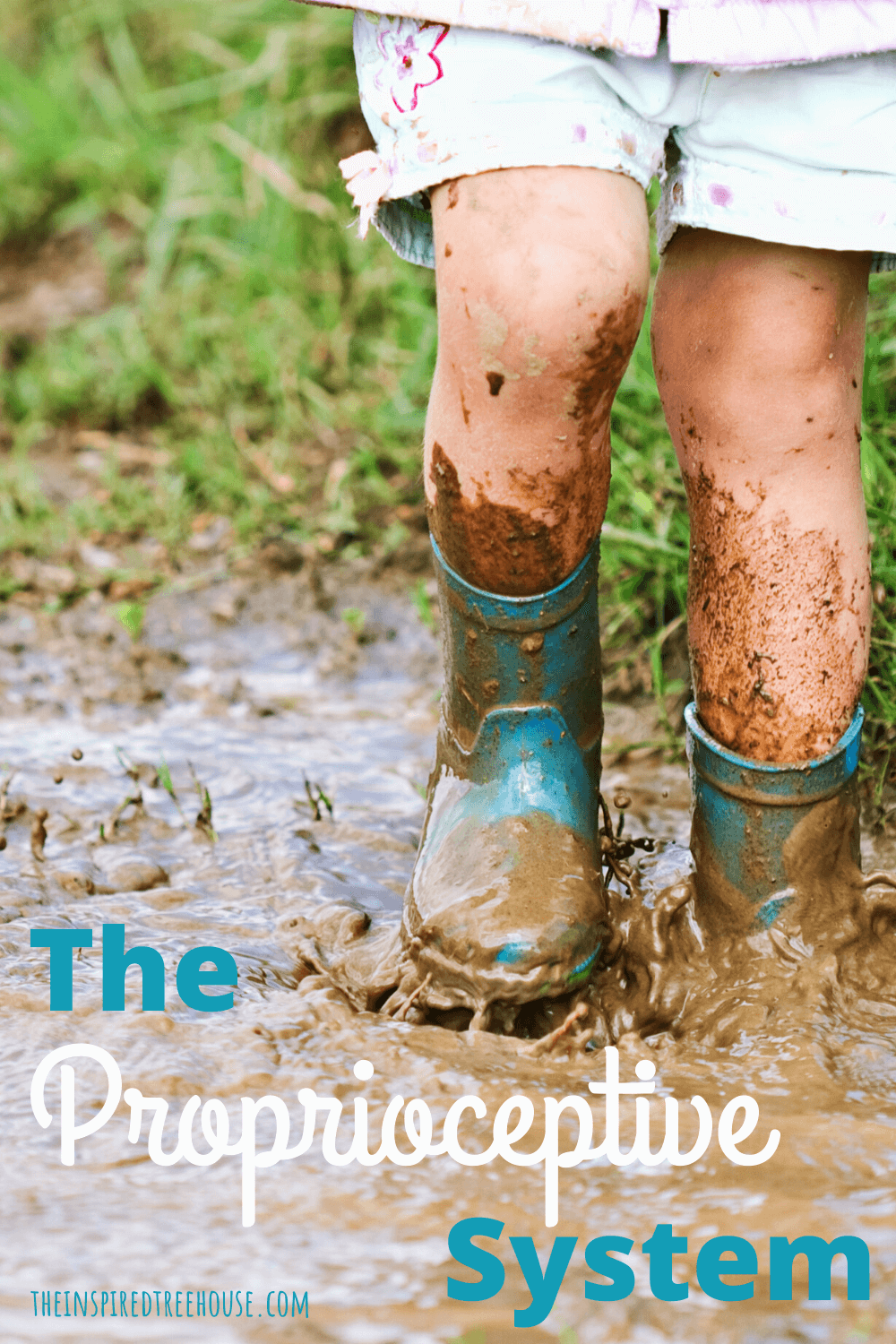Learn more about proprioception and how it is relates to healthy childhood development.
*This post contains affiliate links. Read more.
What is proprioception?
At The Inspired Treehouse, we write about sensory processing from our point of view as pediatric occupational therapists, using our training and experience to break information down into terms everyone can understand.
Today, we’ll talk about the proprioception sense, proprioception examples, and how it’s related to child development. Parents, teachers, and professionals will all feel more confident when they can define proprioception, and understand the meaning proprioception has in kids’ everyday lives.

RISE With Sensory Course
Are you ready to learn powerful sensory strategies to support kids’ sensory needs so they can RISE to their full potential?
Whether you’re a parent or a professional, this course is for you!
The RISE With Sensory Course is This class is AOTA approved for 7 hours (.7 CEU) and is the perfect starting point for new therapists, or refresher for experienced therapists.
Looking for a streamlined approach for working with kids with sensory concerns and for communicating clearly with parents and caregivers about sensory processing?
Click here to learn more!
What Does Proprioception Mean: Proprioception Defined
When children move and play, their muscles stretch and contract. Proprioception refers to the way joints and muscles send messages to the brain to help coordinate movement.
This sense also allows us to grade the force and direction of our movements – our bodies instinctively know to apply more effort when lifting a heavy box and less effort when lifting a piece of paper. While the vestibular system tells the brain about balance and moving against gravity, the proprioceptive sensory system helps us coordinate the movement of our arms and legs in an efficient manner to play and move without even having to look.
For many kids, the proprioceptive system also plays a role in how calm and organized they feel throughout the day. Read on to learn more about this connection and to gain a better understanding of the definition of proprioception.
A Healthy Proprioceptive System
A functioning proprioceptive system allows a child to write with a pencil without pushing so hard that he breaks the tip or take a drink from a Dixie cup without crushing it in his hand. Healthy proprioceptive processing allows children to move, play, and explore in a smoothly coordinated and efficient way – not too gently, not too rough.
Children who have healthy proprioceptive sensory processing can play appropriately with peers and they can function within their environment without crashing into people or objects or playing in a way that is too rough or out of control.
Problems With Proprioception and Sensory Processing: Proprioceptive Dysfunction
When we define proprioceptive processing, it’s helpful to look at some examples. Meet our friend Sam. At school, Sam has a reputation for being the “rough kid”. He pushes other kids in line, he writes and colors with heavy pressure, he plays aggressively with others on the playground. In gym class, Sam doesn’t kick the ball to his partner, he kicks it as hard as he can.
Now, meet Julia. Julia falls out of her chair several times a day. Her writing and coloring is barely visible on paper. She is bumps into walls and other children when moving in the hallway and appears weak and clumsy. She has to look and really think about what she is doing even during the simplest motor tasks like putting on her shoes. Julia sometimes appears tired or sluggish, slumping and leaning in her seat. The gym teacher knows Julia well, and spends extra time with her practicing skills.
Even though these two children have very different appearances, in reality, they both need more proprioceptive input in their daily routine. Proprioceptive activities provide opportunities for heavy work (pushing, pulling, moving against resistance), waking up your muscles and therefore, your mind.
Children like Sam are often called proprioceptive seekers, meaning that they require more proprioceptive input in order to feel grounded, calm, focused, and organized in their bodies. They have decreased proprioceptive awareness and require more proprioceptive movement experiences in order to register the input.
Our Favorite Proprioceptive Movement Activities for Kids
Most children develop a strong proprioceptive sense simply through engaging in everyday play activities that allow for exploration and movement. Others require significantly more proprioceptive stimulation through dedicated activities throughout the day.
There are many activities that can help promote the development of a healthy proprioceptive system by providing proprioceptive input.
What is proprioceptive input? Any movement or position in which the child is working against resistance (pulling, pushing, lifting, carrying, bearing weight) or getting intense input to the joints and muscles (jumping, pedaling a bike, crashing into cushions, deep pressure).
These activities are great for kids who are proprioception sensory seeking and work well as proprioception occupational therapy activities.
Proprioceptive input examples:
-Hit the playground! Kids get amazing proprioceptive input through free play on monkey bars, climbing equipment (climbing walls, ladders, ropes), ziplines, seesaws, and trapeze swings!
-Get involved in community classes and activities for kids such as: swimming (great for whole body movement against resistance), gymnastics, karate, and kids yoga.
–The simplest calming sensory trick: Deep pressure!
-Jumping! Try a trampoline or jumprope.
-Play with tools and toys that provide resistance like stress balls, resistance bands, rubber bands, and hole punches.
–Chores for kids that require movement against resistance: taking out the trash, pushing a vacuum, moving/lifting heavy laundry baskets
–Heavy work activities in the classroom
–Heavy work activities for small spaces

Proprioceptive Activities for Kids
–Create Your Own Roller Coaster
Kids will love pulling their friends along on a ride using the simplest prop that almost everyone will have on hand!
–Wheelbarrow Relay
Another great opportunity for some heavy work and weight bearing – perfect proprioceptive input!
–Pillow Party: 10 Fun Couch Cushion Games
These might just be our favorite activities to stimulate the proprioceptive system while developing a ton of other skills along the way!
–9 Great Play Dough Activities for Kids
Pushing and pulling against the resistance of play dough builds hand strength and coordination while providing input to the proprioceptive system.
-Snowga: A Wintertime Yoga Adventure for Kids
Yoga poses are also a great way to provide the sensory input kids need in a fun and calming way.
-Kids Yoga Stories
Using a yoga story like the one in this post is awesome for sparking kids’ imaginations.
–Obstacle Courses
At The Treehouse, we use obstacle courses on a daily basis to work on balance, coordination, strengthening and for providing crucial sensory input to the proprioceptive and vestibular systems.
The Best Proprioception Toys for Kids
The following list includes some of our favorite toys that we use in therapy and at The Treehouse to provide kids with proprioceptive input that can be calming and organizing to their sensory system.
Climbing Gym
Stretchy Ball
Stress Ball
Pogo Jumper
BouncyBand
Mini Trampoline
Trapeze Bar Swing
Pop Tubes
Crash Pad
Body Sock
Learn More About Sensory Processing
Read up on the rest of the sensory systems by checking out our entire series about sensory processing, including the following posts:
The Vestibular System
The Visual System
The Auditory System
The Oral Sensory System
The Olfactory System
The Tactile System
What is Interoception?
Check out our series on Sensory Processing Strategies for Teens & Older Kids.
Dayna, an early childhood educator and a homeschooling mom of 3, including a little guy with Sensory Processing Disorder, writes about sensory play and sensory activities for kids from a mom and teacher’s point of view.



[…] ones. When they’re positioned on their tummies, babies get all kinds of great tactile and proprioceptive sensory input on their hands, trunks, and legs. This kind of input gives important input to […]